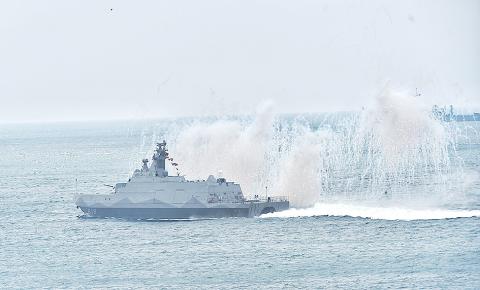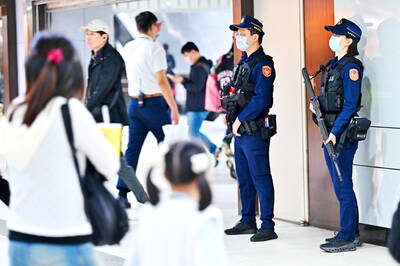Minister of National Defense Yen De-fa (嚴德發) yesterday confirmed plans to bring forward the nation’s construction of 11 Tuo Jiang-class corvettes by completing them in two instead of three phases.
Yen made the comments at a meeting of the legislature’s Foreign Affairs and Defense Committee in response to Democratic Progressive Party Legislator Lo Chih-cheng’s (羅致政) question about whether the military is making adjustments to counter the Chinese threat.
The corvette is a crucial piece of the military’s asymmetric warfare and shortening its construction schedule would increase the nation’s combat capability, Yen said.

Photo: Fang Pin-chao, Taipei Times
The ministry purchased 12 corvettes in total, with the first ship delivered in 2014, it said.
The other 11 corvettes are to come in two types: The first three anti-aircraft models are to be completed by 2025, while five anti-ship models, which were originally scheduled to be completed between 2030 and 2032, are to be brought forward to 2025, the ministry said.
The completion of the third batch, originally planned for 2039, could be moved forward as the need arises, it said.
The armaments of the third batch, whilst unknown, could include the extended range versions of the Hsiung Feng II (HF-II) anti-ship missiles and the HF-III missiles, which offer more effective deterrence against enemy vessels, the ministry said.
With a displacement of 700 tonnes, the anti-air variants are to be armed with ship-launched Tien Chien II missiles, while the anti-ship variant are to carry HF-II anti-ship missiles and HF-III supersonic anti-ship missiles, the ministry said.
The ministry has opted to contract the construction of the surface platforms via an open bid, but would commission the Chungshan Institute of Science and Technology to design and install the combat systems onboard, the ministry said.
The commission agreement and the public bid are to begin next month and should be completed by October, it said.
Navy Command Headquarters Chief of Staff of the Navy Vice Admiral Lee Tsung-hsiao (李宗孝) told lawmakers he is confident that the open bid would conclude successfully and that construction could begin next year.
Construction of the second batch will not necessarily have to wait for the completion of the first batch, Lee said, adding that it could begin as soon as next year or in 2020.
Yen also told the committee that the national defense budget would surely increase more than 2 percent for fiscal 2019.
The ministry will comply with President Tsai Ing-wen’s (蔡英文) instructions on increasing the national defense budget as a percentage of GDP by no less than 2 percent of the previous year’s budget, the ministry’s Comptroller Bureau Director Chen Kuo-sheng (陳國勝) said.

The US government has signed defense cooperation agreements with Japan and the Philippines to boost the deterrence capabilities of countries in the first island chain, a report by the National Security Bureau (NSB) showed. The main countries on the first island chain include the two nations and Taiwan. The bureau is to present the report at a meeting of the legislature’s Foreign Affairs and National Defense Committee tomorrow. The US military has deployed Typhon missile systems to Japan’s Yamaguchi Prefecture and Zambales province in the Philippines during their joint military exercises. It has also installed NMESIS anti-ship systems in Japan’s Okinawa

TRAGEDY STRIKES TAIPEI: The suspect died after falling off a building after he threw smoke grenades into Taipei Main Station and went on a killing spree in Zhongshan A 27-year-old suspect allegedly threw smoke grenades in Taipei Main Station and then proceeded to Zhongshan MRT Station in a random killing spree that resulted in the death of the suspect and two other civilians, and seven injured, including one in critical condition, as of press time last night. The suspect, identified as a man surnamed Chang Wen (張文), allegedly began the attack at Taipei Main Station, the Taipei Fire Department said, adding that it received a report at 5:24pm that smoke grenades had been thrown in the station. One man in his 50s was rushed to hospital after a cardiac arrest

PUBLIC SAFETY: The premier said that security would be tightened in transport hubs, while President Lai commended the public for their bravery The government is to deploy more police, including rapid response units, in crowded public areas to ensure a swift response to any threats, President William Lai (賴清德) said yesterday after a knife attack killed three people and injured 11 in Taipei the previous day. Lai made the remarks following a briefing by the National Police Agency on the progress of the investigation, saying that the attack underscored the importance of cooperation in public security between the central and local governments. The attack unfolded in the early evening on Friday around Taipei Main Station’s M7 exit and later near the Taipei MRT’s Zhongshan

ON ALERT: Taiwan’s partners would issue warnings if China attempted to use Interpol to target Taiwanese, and the global body has mechanisms to prevent it, an official said China has stationed two to four people specializing in Taiwan affairs at its embassies in several democratic countries to monitor and harass Taiwanese, actions that the host nations would not tolerate, National Security Bureau (NSB) Director-General Tsai Ming-yen (蔡明彥) said yesterday. Tsai made the comments at a meeting of the legislature’s Foreign Affairs and National Defense Committee, which asked him and Minister of National Defense Wellington Koo (顧立雄) to report on potential conflicts in the Taiwan Strait and military preparedness. Democratic Progressive Party (DPP) Legislator Michelle Lin (林楚茵) expressed concern that Beijing has posted personnel from China’s Taiwan Affairs Office to its